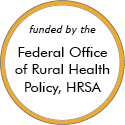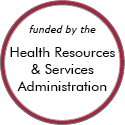Rural Project Examples: Primary care
Promising Examples
Cross-Walk: Integrating Behavioral Health and Primary Care

Updated/reviewed May 2024
- Need: To address and treat substance use disorder (SUD) and depression in the Upper Great Lakes region.
- Intervention: Cross-Walk, a program that integrates behavioral healthcare into primary care services, was developed in Michigan's Marquette County.
- Results: The collaborative efforts strengthened care management services in local healthcare facilities as primary care patients were referred to a behavioral health specialist.
Other Project Examples
Community Care Partnership of Maine Accountable Care Organization

Updated/reviewed April 2025
- Need: To increase access and quality of care for patients in rural Maine.
- Intervention: Community hospitals and Federally Qualified Health Centers in Maine formed the Community Care Partnership of Maine Accountable Care Organization (CCPM ACO).
- Results: CCPM serves about 120,000 patients in Maine. In addition, it has implemented shared savings arrangements/contracts with different Medicare Advantage and other private health payers.
The Pennsylvania Medications for Opioid Use Disorder (PA MOUD) Technical Assistance and Quality Improvement Expansion Project
Added June 2024
- Need: To expand access to medications for opioid use disorder (MOUD) across the state of Pennsylvania.
- Intervention: An initiative formed to provide technical assistance aimed at improving MOUD treatment capacity and quality at healthcare sites across urban and rural Pennsylvania.
- Results: In 2023, 108 providers engaged with the program, treating a total of 5,185 individuals with MOUD. Currently, the program engages partners in 20 Pennsylvania counties – serving rural populations in Crawford, Schuylkill, Susquehanna, Butler, and Cambria counties.
HealthTran
Updated/reviewed March 2024
- Need: Affordable, dependable alternative to bridge the transportation gap between rural Missouri residents and their ability to connect with healthcare providers.
- Intervention: Creation of HealthTran, a sustainable multi-service non-emergency transportation platform model based on the Community Mobility Management framework.
- Results: After national recognition of its initial grant-funded pilot success, HealthTran has further evolved into a sustainable and replicable rural health-centric transportation membership model. Linking patients to appointments with healthcare providers, the model continues to expand further into rural Missouri, with some additional scaling in urban areas.
Hawai'i Island Family Medicine Residency
Updated/reviewed January 2024
- Need: Hawai'i is experiencing a severe shortage of family medicine physicians.
- Intervention: The Hawai'i Island Family Medicine Residency (HIFMR) program uses an interprofessional team-based approach so residents learn how to care for many types of patients in different healthcare settings.
- Results: Since 2017, HIFMR has graduated a class of 3 to 6 Board-certified family medicine physicians annually. Most graduates have remained in the state to practice medicine; those who have left have entered fellowship programs and plan to return to Hawai'i Island to practice.
Premera Rural Nursing Health Initiative at the University of Washington
Added January 2024
- Need: To create rural clinical placement and postgraduate fellowship opportunities for Doctor of Nursing Practice (DNP) students and recent Advanced Registered Nurse Practitioner (ARNP) graduates in Washington.
- Intervention: The Rural Nursing Health Initiative (RNHI), a program out of the University of Washington School of Nursing that created clinical placement opportunities for DNP students and a postgraduate fellowship program for ARNP graduates.
- Results: Rural clinical stipends have been awarded to 80 DNP students, and 12 ARNPs completed rural fellowships between 2021 and 2023.
Health-e-Schools

Updated/reviewed October 2022
- Need: Rural school children lack proper healthcare resources within the school setting.
- Intervention: Health-e-Schools provides health services to students via telehealth using video conferencing and special equipment.
- Results: Health-e-Schools increases access to primary healthcare, increases attendance in the classroom, and decreases the amount of time that parents or guardians must take off of work to bring their child to health-related appointments.
For examples from other sources, see:
